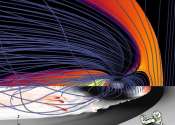Old data, new tricks: Fresh results from NASA's Galileo spacecraft 20 years on
Far across the solar system, from where Earth appears merely as a pale blue dot, NASA's Galileo spacecraft spent eight years orbiting Jupiter. During that time, the hearty spacecraft—slightly larger than a full-grown giraffe—sent ...








